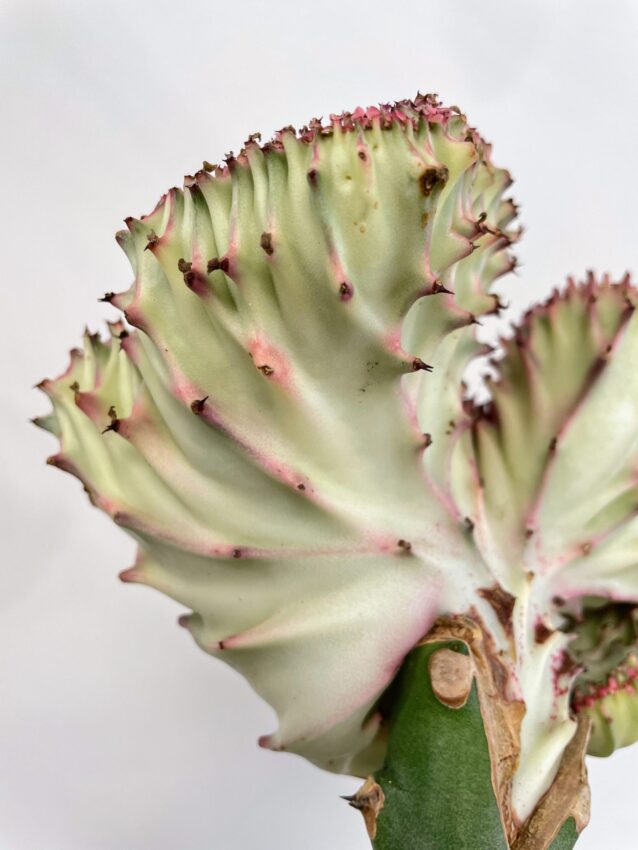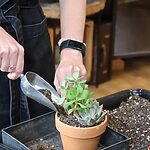About Euphorbia
Euphorbia has to be one of the most weirdly interesting species of plants. The family Euphorbiaceae contains around 2000 different species with almost half of these being categorised as succulents. There are not many other families of plants that have such a wide and eclectic range of species within them. Species can range from annual to perennial, herbaceous shrubs to full-grown trees, being armed with vicious spikes to growing soft and velvety foliage. They really do have something for everyone but the thing that brings them all together as one happy family is the milky white latex sap they produce to heal their wounds and protect them from herbivores.
Being such a large species they cover a huge portion of the globe and are found naturally occurring in a wide range of conditions. They can be found all across Africa, Madagascar, Australia, and the South Pacific in pockets of tropical climates. Euphorbias stretch across the Americas from north to south as well as the more temperate regions of Europe and Asia. They are found growing in grassy lowlands of mountain regions, boarding woodland and tropical forest or in the harsher climates of the savannas. With this wide range of location variety, Euphorbia has developed some striking and downright weird varieties that will leave you wondering if they are really from our planet.
Light
When it comes to houseplant varieties of Euphorbia, they are lovers of bright light as well as enjoying a few hours of direct sunlight. They should be placed in the brightest spots possible near south or west-facing windows.
It is easy to make a mistake with these plants to categorise them as cacti and place them straight into direct sunlight on a sunny window sill. While they can tolerate a few hours of direct light, their skin is more delicate than that of a cactus. This greenhouse effect will cause the skin to scorch becoming damaged and unable to be repaired. Euphorbias can be adapted to tolerating higher levels of direct sunlight but it will take some training before it would be happy to tolerate full sun on a window sill all day.
Humidity
As a general rule, Euphorbia isn’t desperate for the normal levels of humidity most houseplants require. As most Euphorbia varieties hail from warmer climates with dry conditions they suit the average humidity levels of a house (40%). This being said, as long as the ambient temperature is warm, above 25°C, they will tolerate higher levels of humidity. The only time high humidity level will become a problem and start to negatively affect the plant is during winter when it’s cold. If temperatures are cold and humidity is high this is a recipe for disaster for almost all houseplants and can quickly start showing signs of distress.
Water
Water for these plants will vary depending on the time of year and location and will have to be adjusted accordingly.
Euphorbias do almost all their growing in the summer months when ambient temperatures are at their highest, this will be when they require the most amount of water. These plants by no means like to be soaking wet and only require minimal amounts of water. Any more than this and they can become susceptible to root rot and fungal disease. They will also need time to dry out completely between watering, this is where the location of your plant will play a big role in how much warmth the plant is getting and will determine how quickly the soil drys out. While you want the soil to be almost bone dry before watering, it won’t enjoy drying out to the point where the soil shrinks around the edges of the pot, this can lead to yellow and crips leaves and cause some of the growth to shrivel and shrink.
Towards the end of the summer, as we head into autumn, the watering should be continually decreased to almost none as the plant becomes dormant when the temperature continues to drop. These plants tend to get almost no winter rain in their natural environments so will happily stay bone dry until the temperature starts to increase again in the spring.
Soil
As almost all houseplant varieties of Euphorbia are succulents, this plant will need sharply draining soil in order to survive. Plenty of perlite, grit and, sand can be used to ensure that no excess water is being held around the root system.
The perfect conditions for this plant are in slightly acidic soil around PH 5-6 but will happily tolerate neutral to slightly alkaline soil before running into any problems. Grab Your Ready To Go Cacti Mix Here!
Feed
Generally, houseplant Euphorbias don’t require as much of a regular feed as the other plants you may have in your collection. They are more than happy to be fed every 8 to 12 weeks during the summer with a well-diluted liquid fertilizer containing an equal balance of nitrogen-phosphorus-potassium. It is often best to get a succulent-specific feed as this will be best suited to Euphorbia.
Repotting
Repotting your Euphorbia should only be done if absolutely necessary! These plants perform much better when slightly root-bound, it reduces the risk of root rot and can promote flowering. These plants can also suffer from shock when being moved from one pot to another, so tread lightly when thinking of repotting. If your plant is looking healthy and still pushing out new growth it’s probably best to leave it alone.
That being said if you managed to keep your plant for 3 years it may be time to repot. The best time to undertake this task is in spring just before the growing season really gets going. You can step up to the next pot size and if you haven’t already, these plants do much better in terracotta pots. The porous and breathable terracotta works as a sponge drawing the water from the soil into the pot making it the perfect environment to keep your plant extra happy.
- The night before you plan to repot, ensure to water your Euphorbia as this will reduce the risk of shock when moving from the old pot to the new one.
- Gently take the plant out of its pot & brush off any soil clinging to the roots.
- You may need to gently untangle the roots if the plant is heavily pot-bound (If the roots are not roughed up or untangled before repotting, the plant will continue to grow as if it is pot-bound and will suffer despite being transferred to a larger pot).
- Check the root system for any signs of damaged or dying roots, these will be brown and usually a little bit mushy. Simply trim them off to make room for new root growth.
- After trimming, fill ⅓ of your pot with fresh potting mix and place the plant back in the pot.
- Fill the remaining space with your potting mix and gently firm down.
When you’ve finished and got your plant back in the perfect spot you can give it a light watering to settle the plant into its new pot. Keep a close eye on it for the first couple of weeks and then relax back into your normal watering and feeding schedule.
Pests & Diseases
Pests never really seem to be too much of an issue with Euphorbia, with their spikey spines and toxic sap, pests tend to leave them alone and head off in search of more herbaceous plants.
But it is good practice to regularly check your plants for any signs of aphids, red spider mites, mealy bugs, and thrips. You may notice some signs of distress, by checking regularly you allow yourself time to prevent a full-blown attack.
The most common problem with Euphorbia is root rot and fungal disease, which is often caused by overwatering or being kept in an environment with high humidity.
If you have overwatered the plant, it is best to move it to a warmer area where its soil will be able to dry out quickly.
If it is a severe case of overwatering you may need to act fast and repot the plant. Get rid of soggy soil around the roots, remove any dead roots, and repot into fresh soil(insert link). If you have lost a lot of roots to rot it would be best to downsize the plant to a smaller pot.
If you haven’t caught the problem early enough and it has escalated to a fungal disease, the best thing to do is either cut off the affected area (make sure to wear gloves to avoid coming into contact with the white sap) or treat it with a fungicide.

Check our video on homemade pest remedies or head over and read Fungus Gnat Fact Check and Home Remedies how to guide
Troubleshooting & Tips
- Leaves that have curled up and have dried brown edges are a result of a lack of water and too much direct sunlight. It is best to reduce the exposure to direct sunlight and increase your watering.
- Leaves turning yellow and dropping off is a common sign of overwatering. It is best to move the plant to a warmer area where it can dry out quicker.
- Euphorbias will suffer damage if the ambient temperature drops below 12ºC. Early signs of this will be yellow foliage and slow and stunted growth.
- One of the most common issues with Euphorbia is brown spots. If they are light brown and hard, this is likely corking, which is natural as the plant matures. But if the brown spots are darker and squishy, this is a sign of rot. It’s best to remove the rot as soon as possible. For small amounts of rot, you can gently dig out the affected areas until you return to fresh growth. If the rot is covering a substantial area it is best to cut back to a point of fresh growth.
Toxicity
You must always take great care when handling, pruning and repotting Euphorbia. They produce a white milky latex sap whenever the surface of the plant is broken. This sap works naturally as a deterrent to animals and insects that would try to eat the plant.
If the sap comes into contact with your skin, thoroughly wash it off immediately. The sap is phototoxic meaning if it comes into contact with sunlight it becomes more dangerous, causing blistering and severe irritation.
Euphorbias are classed as poisonous and can cause serious irritation, vomiting, and nausea if ingested. So it is best to be kept in a safe location away from children and pets.
Species

Euphorbia Lactea Cristata
This bizarre-looking Euphorbia looks like something you would find attached to a coral reef, this interesting succulent is formed by grafting two succulents together. As a result, you are left with a stunning brightly coloured wavey and undulating coral-like canopy covered in small bumps and spikes. This easy-to-care-for succulent is sure to add intrigue to any room!
Head Over To The Shop To Grab Yours Now!




Euphorbia Trigona Rubra (African Milk Tree)
This Euphorbia is disguised as cacti with its unique triangular stems covered in sharp thorns and small teardrop leaves along the edges. The centre of the stems is pale lime green as it bleeds outwards becoming darker with red tints towards the edge. In Africa, its native environment, the plant is often used as hedging due to its vigorous growing nature.


Euphorbia Ingens Variegata Ghost Cactus
The ghost cactus is one of the more rare forms of Euphorbia. Its pale yellowy green complexion and rows of spines along the undulated edges make for a striking plant. These incredibly hardy plants are fast growers and can reach up to 6ft tall if well looked after.
Head Over To The Shop To Grab Yours Now!





Euphorbia Pulcherrima (Poinsettia)
This house plant classic is one of the country’s all-time favourites with almost 8 million of these being sold every year! These plants come to life in winter displaying vivid and showy red, cream or pink bracts(modified leaves) with small delicate yellow flowers blooming from the centre of the gorgeous bracts.




If you enjoyed this guide head over to Articles & Blogs to learn more or check out our YouTube for even more useful information!











